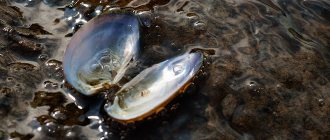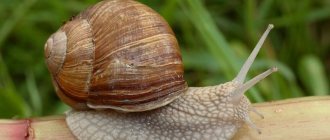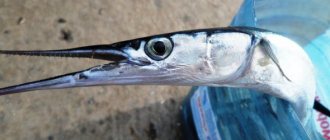The loach is a fish that is amazing in appearance and characteristics. But it is specially caught in rare cases, despite the fact that its meat is very tasty and healthy. Loaches are extremely rarely caught by fishermen. This fish can adapt to even the most unfavorable conditions in the pond. The worse the living conditions in a reservoir, the higher the likelihood of catching a loach fish. Next, you can read its description in more detail, find out what bindweed eats, where it is found and how it reproduces.
Are you familiar with the crucian fish?
Yes
100%
No
0%
Voted: 1
Description
The loach is a freshwater ray-finned fish, a member of the Loach family. It lives in Central and Eastern Europe.
The main difference between the loach fish is its elongated, streamlined body; in its shape and appearance it looks like a snake. The body length varies from 8 to 30 cm. The average body weight is 100 g. On average, the lifespan of this aquatic inhabitant is 10 years.
In another way, the loach is also called the squeak. It received this name because during catching it makes thin squeaking sounds and wriggles its whole body, looking like a snake. There are no scales on the surface of the body; in some places there may be scales, but they are very smooth and practically unnoticeable. The surface of the skin is covered with a dense ball of mucus, so catching such a fish is quite difficult. Bindweed cannot stay at depth for a long time, so it is forced to cover the distance in short bursts.
Yandex pictures
The appearance characteristics are as follows:
- the head is not large, slightly flattened in shape from the side and extended forward;
- the eyes are small, the iris is yellow;
- near the mouth on both sides there are five pairs of thick and long antennae;
- there are no teeth in the mouth;
- there is a short fin on the surface of the back, it is located closer to the caudal fin;
- the classic body color of the loach fish is brown, there are dark markings on the surface of the body;
- the abdominal part is colored light yellow;
- the color of the scales depends on the quality of water, habitat and type of soil;
- the fins are poorly developed, the caudal fin is the largest, single-lobed, rounded at the end, the dorsal and anal fins are displaced towards the caudal fin.
Yandex pictures
The common loach has a cylindrical body shape. The coloring is contrasting and quite interesting. The surface of the back is painted brown, there are numerous dark spots and inclusions. The sides have broad olive or brown stripes. Sometimes in nature you can find albino loaches, which have a completely colorless body. The biotope affects the color intensity. In clear waters the skin tone is lighter, while in turbid waters the skin becomes darker.
Interesting. This fish has an amazing feature - it can predict the weather. Bindweed reacts very sensitively to any changes in atmospheric pressure. Therefore, before weather conditions worsen, they begin to behave restlessly - they float to the surface of the water 10 times per minute. For this ability he was nicknamed the weather forecaster. In those countries of the world that are earthquake-prone, loaches are specially kept in aquariums so that they can warn people that a disaster is approaching - a tsunami, earthquake, typhoon or hurricane.
This fish is an important part of the food chain; it is often hunted by predatory fish - perches, burbot and pike. It has no serious commercial significance. More often used by fishermen as bait for catching other types of fish.
The sexual dimorphism of the loach fish is well expressed. The body size of the female is much larger than that of the male, the body is longer and more massive. Also, in males, the pectoral fins are elongated and pointed. A large number of tasty and healthy dishes can be prepared from the meat of this fish. The fillet is practically boneless and easy to cut. But it is almost impossible to find such a product on sale. Loaches are not caught en masse, except by order of some fish stores and large restaurants. Local residents catch this fish and sell it in markets.
Loach - prey
The loach is not popular among fishermen because of its unpleasant appearance and squeaking sound, which is so uncharacteristic of fish. Again, the smell of silt and mud. What can you do, where you live is how you smell! However, its meat is not inferior in taste to many other varieties.
In the end, the pike also gives off mud, which does not prevent it from being a desirable catch. By the way, in Asia this fish is considered almost a delicacy. The population of those countries discovered centuries ago that dishes made from this inconspicuous fish are very beneficial for health.
How could it be otherwise if, after dining on loach, you will receive, in addition to satiety, a complex of vitamins A, B and D, which will help your body ensure the health of the mucous membranes, produce sex hormones, increase body tone, strengthen the immune system and heart muscle.
A good seasoning would be fatty acids and amino acids, as well as microelements such as magnesium, potassium, fluorine, zinc and iodine. I guarantee your body will be grateful for such support!
Now let's get down to business, that is, catching loaches. The work is generally not difficult. Experienced fishermen always know where a given fish lives and catch it in winter and summer in the required quantities.
- In cold weather, it is enough to break the ice in a reservoir and all the loach in the area will quickly gather in the formed hole. He will run for oxygen! He needs to breathe!
- Then you can scoop it out with a net, a fish tank, a basket, or even with your bare hands (if you can hold it! It’s very slippery!).
- But if you are not a fan of such barbaric methods and prefer the classic version of fishing with a bottom or float rod, then there are no obstacles either.
- Most often, a fishing line with a diameter of 0.15 - 0.25 mm is used, and a hook number 5. Any worm will serve as bait. Be it rain or dung.
The main thing is to ensure that the hook with bait drops exactly to the bottom. Then the loach (if it exists in these places) is one hundred percent yours! But if you are unlucky with a worm, you can safely hook bloodworms, larvae of any insects, slugs, small mollusks and even small leeches.
There have been cases when a starved loach swallowed a bare hook! You can catch this fish both day and night.
What does it eat?
This fish is a predator in its lifestyle. The diet is based on small river inhabitants:
- invertebrates;
- insect larvae;
- crustaceans;
- shellfish
Yandex pictures
Squeak has learned to find and eat eggs that are on the surface of the lake bottom. He does this faster than other aquatic inhabitants. The basis of the diet of the aquarium loach are:
- raw meat;
- bloodworm;
- worms;
- ant eggs.
The squeaker gropes for such food using its whiskers at the bottom of the aquarium.
Fishing for squeaker
Professional fishermen and fishing enthusiasts claim that you can catch squeaker throughout the year. There is also winter fishing for loach, and it is quite successful. Many fishermen use fish as bait to catch predatory species such as pike.
After catching, the loach is active even without water for 24 hours, which makes it possible to use it to attract predators. They catch the squeaker using float gear with extreme caution, since it is quite difficult to hold a squirming specimen.
This fish is a representative of cyprinids
Any type of squeaker is suitable for home keeping, since the fish is unpretentious and non-aggressive. However, due to excessive activity, individuals are kept separately from others. The activity of the squeak creates a stressful situation for other inhabitants of the aquarium, and its gluttony does not allow other species to feed normally.
The loach fish is a unique representative of the carp family, which is ideal for eating and keeping at home. With proper care, breeding it yourself will not be difficult, and its unpretentiousness in food will save money.
Where does it live?
The loach fish is a fairly common species. She lives in reservoirs of Eurasia, East and South Asia. A lot of loaches are found in the reservoirs of France; they can also be caught in the Ural Mountains. It prefers to be in muddy soil, in mud, where it is comfortable for it to hide for the winter. They prefer freshwater bodies of water with slow currents:
- ditches;
- swampy backwaters;
- mud channels;
- stagnant lakes.
During the day, the loach fish sleeps, and at night it wakes up and goes out fishing, looking for prey. Its favorite place is overgrown muddy pools. In rivers, such inhabitants are found only in areas with dense aquatic vegetation, where the flow is slow, where there are many branches and reeds. It is in such territories that the fish feels safe; it easily hides from its natural enemies, burying itself in the muddy bottom. Such a habitat is beneficial for this aquatic inhabitant, because when the water level in the reservoir drops, it can remain in a puddle or ditch, and it is in such conditions that it feels comfortable.
Loach fish can often be found in deep ditches with a soft bottom. In swampy reservoirs that are covered with duckweed and have a muddy bottom, you can find many of these representatives of aquatic fauna. It is quite difficult for other fish to survive in such conditions, but for the loach such conditions are ideal.
The loach adapts to even the most unfavorable conditions and can survive if the swamp dries out almost completely. It will simply begin to burrow into the muddy bottom. Since it has a unique anatomical body structure, it can easily move not only in muddy, but also in heavily polluted waters.
Interesting. If a fish senses water near the dry areas of a reservoir, it will crawl towards it through the grass, like a snake. You can catch bindweed at this moment with your bare hands.
Natural enemies
The natural enemies of loaches are fish that are larger in size:
- pike;
- perch;
- burbot.
Yandex pictures
Fishermen often use loach meat cut into pieces to catch larger specimens. This bait is used to catch the natural enemies of this representative of the aquatic fauna.
Area
The loach is widespread in fresh water bodies of Europe, but is absent from the Iberian Peninsula, Italy, Greece, Great Britain, Scandinavia, the Arctic Ocean basin, Crimea and the Caucasus; in the Amur basin it is represented by a special subspecies. In Belarus it is found everywhere, mainly in stagnant floodplain reservoirs, more often in silted, overgrown lakes, oxbow lakes, bays, floodplain swamps, less often in swampy rivers and ditches. It is especially widespread in Polesie reservoirs.
In aquarium
Loach fish can be kept in an aquarium. For this you need a spacious container. One adult requires at least two hundred liters of water. But it is better to keep such pets in flocks, so the container needs to be even larger in size. The loach leads a bottom-dwelling lifestyle, so it needs to be provided with maximum bottom area. The aquarium must be covered so that the fish does not jump out of the water.
Yandex pictures
The optimal soil is coarse or fine river sand; it is necessary to pour a thick layer of at least 5 cm. To ensure a comfortable existence for such animals, you need to equip the aquarium with shelters made of driftwood, stones, and cuttings of plastic pipes. It is better not to plant living plants, for the reason that the loach is indifferent to them, but when looking for prey on the surface of the bottom, it may accidentally dig up the plants.
The light should be diffused, dim, as for other animals that are nocturnal. To create diffused light for your pets, you can launch floating plants onto the surface of the water:
- pistia;
- riccia;
- hornwort.
It is important to equip the aquarium with a high-quality filtration system; good aeration is also necessary. The water temperature should not be higher than 22 degrees Celsius. Once a week, change a third of the water, adding fresh, settled water.
Yandex pictures
Compatibility
Although loaches are predators, they are not aggressive. It is quite possible to keep them in the same aquarium with many species of fish, which, by their nature, are also not cruel and merciless individuals. It is noteworthy that they do not conflict with their own kind, especially with same-sex individuals, unlike other aquarium inhabitants.
Angelfish, calm-tempered cichlids, parrotfish and many others will get along well with loaches. You just need to take care of a spacious home, because the snake-like loach fish itself in an aquarium can grow to impressive sizes, and its possible neighbors listed above are among the rather large inhabitants of the improvised underwater world, equipped in a human house or apartment. Sometimes it happens that owners purchase small aquariums specifically for the purpose of raising several different babies there, but after 9 months or a year they are sure to place the matured individuals in spacious dwellings.
Reproduction and spawning
Adults become sexually mature when they are three years old. Sex differences are pronounced:
- the male is smaller in size than the female;
- in males the pectoral fin is much longer with a thickened second ray;
- the pectoral fins of males are triangular in shape, while those of females are rounded;
- The male has a fatty growth near the dorsal fin.
The spawning period lasts from April to July. Females are very fertile; they can lay about 30 thousand eggs in one spawning period. They spawn on the surface of dense aquatic vegetation. The eggs are small, no more than two millimeters in diameter, and are poorly attached to objects. Incubation lasts about four days, then the larvae hatch. They have external gill covers. After two weeks, the fry begins to feed on its own. They search for their food supply using sensitive antennae and mouthparts. Young individuals grow and develop quickly.
Interesting Facts
There are several interesting facts about fish from the loach family. They may be useful to a novice aquarist who is wondering about the characteristic features of an individual and its behavior, so we will list them:
- Night barometer - that’s what the fishermen called the loaches. The fact is that before bad weather, representatives of this amazing family begin to rise to the surface. They stick their cute little faces out of the water, as if they are watching what is happening.
- Interestingly, the river loach fish loves the eggs of other fish, and therefore destroys the populations of many representatives of the underwater world. Their favorite delicacy includes the offspring of crucian carp. Before adding goldfish to the loaches, you should think again, because if you find masonry in the aquarium, the loach will certainly feast on it.
- The snake-like fish itself often becomes easy prey for pike, catfish, perch and burbot.
- Another name for the fish is squeak. This is explained by the fact that when caught, it begins to squeak furiously when they try to pull it ashore.
- Loach fish prefer to hide in aquariums just like in nature. Grottoes and other shelters will come in handy for them, which also play an aesthetic role (an artificial home pond can be decorated in any theme: from an abandoned bay with a long-sunk ship to a rocky canyon).
- Loaches play an important role in nature. They exterminate mosquitoes and their larvae, so the benefits of these representatives of fresh water bodies are very great.
Fried
To prepare fried loach, you need the following ingredients:
- carcasses – 1 kg
- salt, spices for fish
- flour or breadcrumbs
- vegetable oil for frying
Cooking:
- Wash and prepare the carcasses; you can cut them into portions.
- Pour oil into a hot frying pan.
- Roll the fish slices in salt and spices, then roll them in flour.
- Place in hot oil and fry for three minutes on each side.
Place on paper towels to remove excess fat.
Yandex pictures











